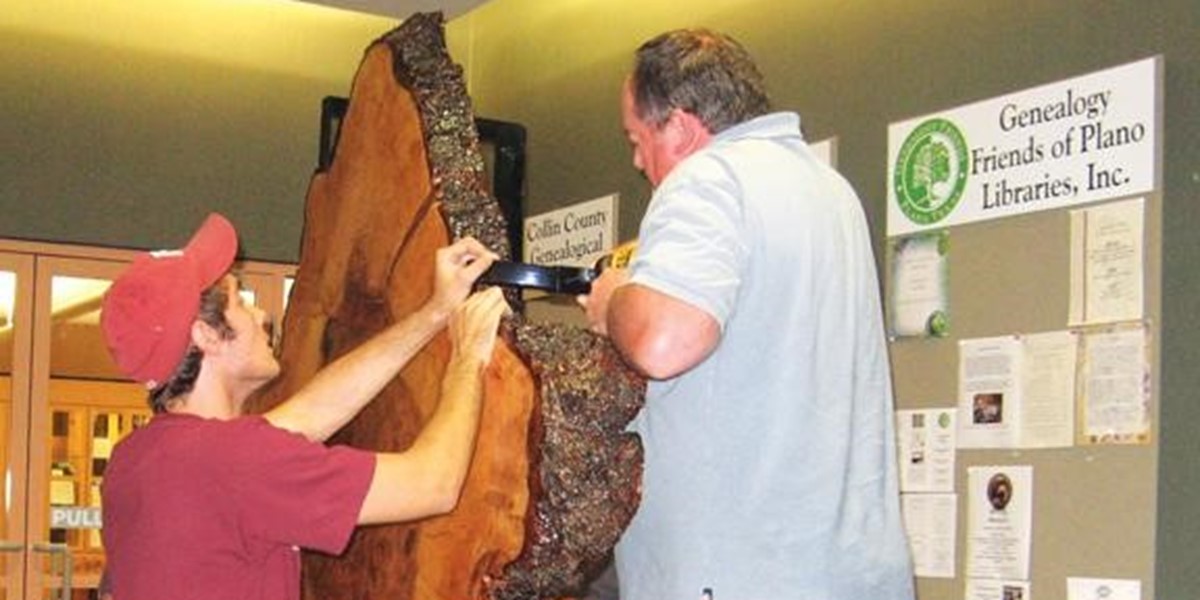

Published June 4, 2012 by KELLEY CHAMBERS
Haggard Library is boasting a sweet treat rich in Plano history thanks to a local Eagle Scout candidate.
With the help of family and friends, Daniel Duncan of Richardson recently installed a "cookie," or tree cross-section, from a 79-year-old pecan tree that was cut down near the 10th hole of Pecan Hollow Golf Course.
The Plano Senior High School senior said luck had a little bit to do with the endeavor, as he had been researching potential Eagle Scout service projects in the area since last summer. After going through what he called a "dry spell," Duncan contacted the city of Plano in August and was told about the long-standing tree which had been cut down.
"It kind of all just fell into place," Duncan said. "The typical [Eagle Scout] project is building a park bench or planting trees, so this was kind of neat. I'd never heard of anyone do this. This is something I can show my kids and it'll be there for a long time."
Labels on the rings of the "cookie" detail dates of local historic significance between 1932 and the present day, including the price of gas in 1955, Plano's 100th anniversary in 1973, the fall of the Berlin Wall and the opening of the Haggard Library in 1989, and when the DART Rail began running in Plano in 2002.
A dedication ceremony took place on May 4, the "cookie" is currently on display on the lower level outside the Genealogy, Texana and Local History archives.
"There are so many people that dedicated their time, energy and resources to make this project possible," said Candace Fountoulakis, a data collection technician with the city's parks and recreation department, who also volunteers in a variety of area historic preservation pursuits, including The Plano Conservancy for Historic Preservation and the RIP Guardians of Young Cemetery. "We also thank Haggard Library for agreeing to accept this donation of this enormous piece, which was no small feat to fit in its resting place."
A committee submitted ideas, then Fountoulakis chose the ultimate labels, which had to fit in the space allowed on the surface. The width of the rings varies with the growth of the tree, reflecting conditions of weather, rainfall and temperature while it was growing. In the end, Fountoulakis said, it was a combination of local history, natural history and a bit of artistic selection.
"The tree cookie idea is one that has been done in the past to show how a tree's rings reflect its annual growth and makes a natural timeline to link to events that occur during a tree's lifespan," she said. "Museums all over the world have used cross sections taken from famous, huge or unique trees and used them to show their visitors events 'witnessed' by the tree while it continued to grow."
The major challenges Duncan faced pertained to the initial drafting and planning, which included acquiring the materials, coming up with a procedure and getting it approved, all the while coordinating with others who could lend their professional expertise to the project. The Plano Conservancy for Historic Preservation helped by consulting with Duncan on the stand's construction, and allowed Duncan to review the blueprints from a similar stand in their collection.
"The first step was the hardest, and the stand had to be professionally welded," he said. "Luckily, my dad works at Addison Airport, and he knew a fellow employee who did the welding. I learned that cutting at 45-degree angles was so challenging, and making that base square was a pain."
In addition to involvement from the parks department, other players had a role in transforming the tree into a historical display. For example, Arborilogical Services recommended a sealant to slow down the drying process while Duncan and his team decided how to proceed with the "cookie," finding a donor and a woodshop to tackle re-cutting and finishing the piece. The entire project, from stand construction to tree preservation and installation, took roughly four months to complete.
"It looks so good and I felt so proud," Duncan said. "It's a very memorable experience and it's going to be there for years [to come]; I think it's pretty neat."
